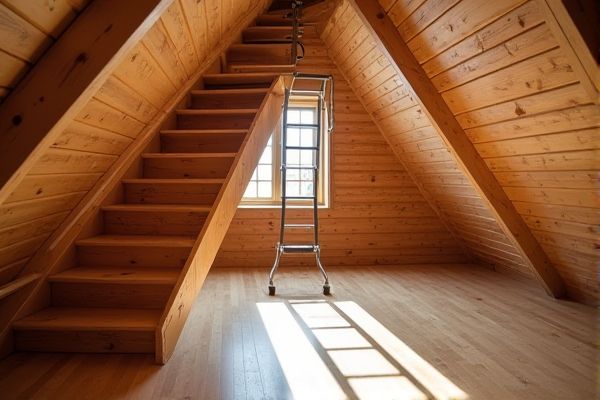
Attic steps offer a sturdy, foldable option permanently installed in the ceiling, providing easy access with solid wooden or metal steps, while attic telescoping ladders excel in portability and compact storage, sliding neatly into small spaces and extending as needed. Explore the detailed comparison to determine which solution best fits your storage needs and space constraints.
Table of Comparison
| Feature | Attic Steps | Attic Telescoping Ladder |
|---|---|---|
| Design | Folding, multi-panel stair design | Telescoping, compact retractable ladder |
| Material | Typically wood or metal | Aluminum or lightweight metal |
| Installation | Requires ceiling framing and secure mounting | Simple mounting, space-efficient setup |
| Space Usage | Takes more ceiling and floor space when opened | Compact, takes minimal ceiling space |
| Weight Capacity | Generally supports higher weight (up to 350 lbs) | Moderate weight support (up to 300 lbs) |
| Ease of Use | Stable stair steps, easier to climb | Requires careful extension and retraction |
| Maintenance | Low maintenance, durable construction | Occasional lubrication and inspection needed |
| Cost | Typically higher initial cost ($150 - $300) | Generally lower cost ($100 - $200) |
| Best For | Frequent attic access requiring stability | Infrequent use with limited ceiling space |
Introduction: Choosing Between Attic Steps and Telescoping Ladders
Attic steps provide a permanent, sturdy solution for easy access to attic spaces, featuring a foldable wooden stair system integrated into the ceiling. Telescoping ladders offer a compact, space-saving alternative that extends vertically to reach the attic, made from lightweight aluminum or fiberglass for portability. Evaluating ceiling height, frequency of use, and storage space is crucial when selecting between attic steps and a telescoping ladder.
Key Differences: Attic Steps vs Telescoping Ladders
Attic steps are permanent fixtures built into your ceiling, providing sturdy, foldable access with wide treads and handrails for enhanced safety. Telescoping ladders, by contrast, are portable, extendable systems made for flexibility and easy storage, often constructed from lightweight aluminum. Choosing between attic steps and telescoping ladders depends on your space, frequency of use, and preference for either permanent or movable access solutions.
Space Requirements and Installation Comparison
Attic steps typically require a larger floor opening and more overhead clearance, making them better suited for spacious areas with high ceilings. Telescoping attic ladders are designed to compactly retract into a smaller floor opening, ideal for limited space scenarios with low to moderate ceiling heights. Installation of attic steps often demands structural framing and more labor, while telescoping ladders offer easier, quicker installation with adjustable length for versatile fit.
Safety Features and Stability
Attic steps provide superior stability with their fixed installation and robust hinge mechanisms, reducing the risk of wobbling or collapsing during use. Attic telescoping ladders offer compact storage but may lack the same level of rigidity, relying on locking mechanisms that must be carefully maintained to ensure safety. Choosing attic steps often results in enhanced safety features such as wider treads, secure handrails, and reinforced support brackets designed for consistent load-bearing.
Weight Capacity and Durability
Attic steps typically have a higher weight capacity, often supporting up to 300 pounds due to their robust wooden or metal construction, making them suitable for heavy-duty use. Telescoping attic ladders, while more compact and space-saving, generally support weights between 250 to 300 pounds, but their aluminum or steel design offers excellent durability and resistance to corrosion. Choosing between the two depends on balancing weight capacity needs with available attic space and frequency of use.
Ease of Access and Usability
Attic steps provide a sturdy, fixed solution that ensures ease of access with a traditional staircase design, resulting in a comfortable and secure climb. In contrast, an attic telescoping ladder is compact and space-saving, ideal for occasional use but may require more effort to pull down and set up. Your choice depends on whether you prioritize consistent usability and stability or space efficiency and portability.
Cost Analysis: Attic Steps vs Telescoping Ladders
Attic steps typically cost between $150 and $300, offering a sturdy, permanent solution with higher initial investment but increased durability. Telescoping ladders range from $80 to $200, providing a budget-friendly, compact option but often lacking long-term robustness. Cost analysis favors telescoping ladders for affordability and space-saving benefits, while attic steps present a costlier yet more reliable and lasting installation.
Best Scenarios for Each Option
Attic steps are ideal for permanent access to frequently used attics, providing a sturdy, fold-down staircase suitable for carrying larger loads or multiple trips. Telescoping ladders excel in spaces with limited headroom or irregular attic openings, offering a compact, adjustable solution that is easy to store and transport. Homeowners prioritizing convenience and durability should opt for attic steps, while those needing space-saving flexibility benefit more from telescoping ladders.
Maintenance and Longevity Considerations
Attic steps typically require regular inspection of hinges and spring mechanisms to prevent squeaking and ensure smooth operation, contributing to their long lifespan. Telescoping ladders demand occasional lubrication of sliding sections and careful alignment to avoid jamming or wear, which can affect durability over time. Both options benefit from proper cleaning and avoidance of excessive weight to maintain structural integrity and extend functional longevity.
Conclusion: Making the Right Attic Access Choice
Choosing between attic steps and an attic telescoping ladder depends on your specific space constraints and frequency of use. Attic steps provide a sturdy, permanent solution ideal for regular access, while telescoping ladders offer compact storage and flexibility for occasional use. Evaluating your attic's size, ceiling height, and ease of installation will ensure your choice maximizes safety and convenience for your home.
 homyna.com
homyna.com